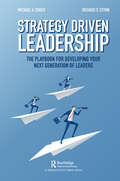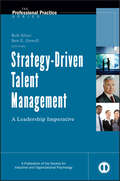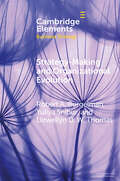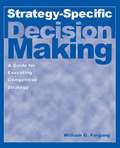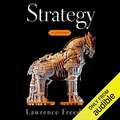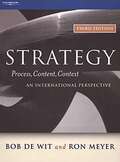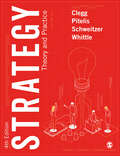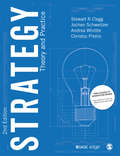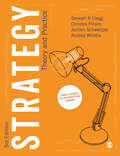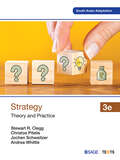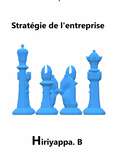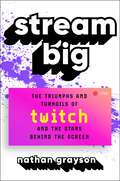- Table View
- List View
Strategy, Value and Risk: Industry Dynamics and Advanced Financial Management (Global Financial Markets)
by Jamie RogersThe current transformation of the global economy is being driven by new fundamental innovations, digitalization, industry dynamics and climate change. The impact of this transformation in terms of value migration, industry boundaries, investment and firm continuity is vast. The fourth edition of Strategy, Value and Risk examines these issues, and how they will influence firms and industries in the future. Those aspects of the business environment that will have a significant impact on strategy, business models, investments and value are identified, and the accounting, finance, economic and quantitative principles that provide a foundation for the analysis of these issues are discussed.Part I: Strategy, Value and Risk provides the strategic, economic, accounting and financial framework. Strategy discusses technology and innovation, industry dynamics, globalization and industry concentration, climate change, industry boundaries and future value. Value discusses the accounting framework and corporate finance and investment, while Risk covers investment risk, corporate risk management and value and risk. Part II: Quantitative Analytics provides an overview of financial statistics, derivatives and derivative applications, and provides a background on the financial economics used in the analysis of physical, intangible, financial and energy assets. Part III: The Analysis of Investments, Transformation and Value examines platforms, data and analytics, the energy sector, pharmaceutical and biotech, a growth firm and media transformation, and applies the accounting, economic, financial and quantitative concepts.This fourth edition lays out scenarios that will likely shape firms and industries in the future, and has relevance to CFOs, corporate finance and investment professionals. Business model disruption, data and analytics, intangible assets and dynamic analysis are now key issues within the CFO role. Investment professionals are required to see the larger economic environment in which firms compete, assess a firm’s industry and its position within that industry, recognize which investments best serve its broad strategic goals and identify a firm’s capabilities and options. A background in the accounting, finance, economic, quantitative and valuation concepts that are relevant to the digital economy, new industries, business models and technologies is essential for finance professionals. This book addresses these issues within the context of the fundamental changes underway in the global economy, and provides applications of the techniques to illustrate the concepts.
Strategy-Driven Leadership: The Playbook for Developing Your Next Generation of Leaders
by Michael A. Couch Richard S. CitrinIt’s estimated that U.S. companies spend over $14 billion annually on leadership development --Match that number to the abundant and growing research that finds most leadership development to be ineffective, and the conclusion is a phenomenal amount of waste. The remedy for this situation is to have business strategy drive leadership development instead of creating programs that match a one-size-fits-all approach to leadership. This book's approach, called Strategy-Driven Leadership Development (SDLD), puts business strategy first. It maintains an emphasis on building leadership programs around what it will take to make the business successful as opposed to implementing a program in the hopes that it will benefit the strategy. The result is a differentiated and targeted approach called Intentional Leadership Development, which provides the structure for transforming how leadership development is undertaken. At the heart of this book, however, is the explanation of how small, incremental changes in action and perspective create meaningful changes in the way leadership is developed. The focus is on the leadership behaviors associated with success for any company. Some companies may need leaders with better financial acumen while others may require better teamwork for success. These skills are learnable and when the energy of an organization is behind it, then leadership development can be transformational. The authors method "retools" prior leadership efforts – the emphasis is not on previous failures and restarting with new programs. There are many effective ideas and actions that are currently embedded in leadership programs, but they miss the critical element of tying their efforts to the business strategy. Strategy-Driven Leadership changes the way organizations think about and drive their leadership talent initiatives among their current and upcoming leaders. The book is filled with research, science-based information, case studies, and practical hands-on tools on why and how this Strategy-Driven Leadership Development model will transform company leadership approaches.
Strategy-Driven Talent Management
by Rob Silzer Ben E. DowellProfessionals are searching for an integrated approach to building and sustaining leadership talent. This volume in the SIOP Professional Practice series provides an up-to-date perspective on current talent management practices in business organizations. Bringing together a collection of thought leaders and managers from noted organizations, this book presents state-of-the-art ideas, best practices, and guidance on how to recruit, select, assimilate, develop, compensate, and retain exceptional leaders. It contains the knowledge, research, and experience in developing and implementing those practices and initiatives, and provides an effective resource for I/O psychologists and HR professionals.
Strategy-Focused Organization FAQ
by Robert S. Kaplan David P. NortonThe authors of "The Strategy Focused Organization" have encountered several recurring questions in their public talks and seminars covering the material of the book. In this chapter, they answer some of the most frequently asked questions.
Strategy-In-Practices: A Process-Philosophical Perspective on Strategy-Making (Elements in Business Strategy)
by David Mackay Robert C. ChiaThis Element maintains that increasing strategic effectiveness involves paying greater attention to the idiosyncratic capabilities and know-how already accumulated in an organization's shared practices and the modus operandi contained therein. An organization's modus operandi describes the practiced patterned regularities that enables it to achieve a consistency of response in strategic circumstances even in the absence of any clear, formalized strategic plan. This patterned regularity known as Strategy-in-Practices (SiP) draws attention to the tacit influence of an organization's shared practices on its formal strategy-making efforts. It emphasizes the need for both these to be aligned so that the organization is better prepared to cope with the challenges and opportunities it faces.
Strategy-Making and Organizational Evolution: A Managerial Agency Perspective (Elements in Business Strategy)
by Robert Alexander Burgelman Yuliya Snihur Llewellyn Douglas ThomasThis Element presents several frameworks of strategy-making that serve to analyze organizational evolution processes within and beyond the firm. These frameworks form an integrated evolutionary ecological lens to examine the dynamics of strategy-making in organizational evolution. They highlight the role of the internal selection environment for analyzing processes and practices at various managerial levels (top, middle, and operational) within the organization. The Element also explains the role of the CEO in maintaining and updating the internal selection environment and contributing to organizational evolution, as well as making. fundamental decisions about organizational splits of the firm's business models as an ecosystem evolves.
Strategy-specific Decision Making: A Guide for Executing Competitive Strategy
by William G. ForgangProviding a novel approach to business policy and strategic management, this book focuses on the implementation of a firm's competitive strategy throughout all levels of the organization.
Strategy: A History
by Lawrence FreedmanIn Strategy: A History, Sir Lawrence Freedman, one of the world's leading authorities on war and international politics, captures the vast history of strategic thinking, in a consistently engaging and insightful account of how strategy came to pervade every aspect of our lives. <p><p> The range of Freedman's narrative is extraordinary, moving from the surprisingly advanced strategy practiced in primate groups, to the opposing strategies of Achilles and Odysseus in The Iliad, the strategic advice of Sun Tzu and Machiavelli, the great military innovations of Baron Henri de Jomini and Carl von Clausewitz, the grounding of revolutionary strategy in class struggles by Marx, the insights into corporate strategy found in Peter Drucker and Alfred Sloan, and the contributions of the leading social scientists working on strategy today. The core issue at the heart of strategy, the author notes, is whether it is possible to manipulate and shape our environment rather than simply become the victim of forces beyond one's control. <p><p> Time and again, Freedman demonstrates that the inherent unpredictability of this environment - subject to chance events, the efforts of opponents, the missteps of friends - provides strategy with its challenge and its drama. Armies or corporations or nations rarely move from one predictable state of affairs to another, but instead feel their way through a series of states, each one not quite what was anticipated, requiring a reappraisal of the original strategy, including its ultimate objective. Thus the picture of strategy that emerges in this book is one that is fluid and flexible, governed by the starting point, not the end point. A brilliant overview of the most prominent strategic theories in history, from David's use of deception against Goliath, to the modern use of game theory in economics, this masterful volume sums up a lifetime of reflection on strategy.
Strategy: A Primer
by Richard LueckeOperational efficiency is about doing things right; strategy is about doing the right things. This chapter focuses on how to formulate strategies that will differentiate your enterprise, giving it competitive advantage, and on how to scan the horizon for new opportunities or for changes that may undermine your current strategy.
Strategy: Aligning Star Performers with Strategic Goals
by Jay W. Lorsch Thomas J. TierneyWinning is tough in the dynamic professional services marketplace, where stars drive a firm's strategic decisions as well as the implementation of those decisions. How do outstanding firms achieve their strategic goals given the inherent tensions, complexities, and risks they face in this environment? This chapter examines strategy in depth, outlining the organizational characteristics that promote a firm's efforts to implement its strategy.
Strategy: Past and Future--The Problem of Strategic Behavior in Discontinuous Environments
by Stephan H. HaeckelStrategy-as-plan has ceased to be a viable option for most large organizations because creating an overall plan of organizational behavior requires the ability to predict or control the future, an ability that increased discontinuity has all but eliminated. Pervasive uncertainty about customer preferences calls into question the usefulness of both strategic plans and the business structures designed to carry them out. This chapter looks at the potential benefits and pitfalls of adopting an emergent strategy, which implies reactive rather than proactive behavior, as well as the decentralization of the traditional organization.
Strategy: Process, Content, Context--an International Perspective
by Ron Meyer Bob De WitBob De Wit and Ron Meyers innovative and extremely successful strategy text encourages critical and creative strategic thinking. By introducing articles from key strategists to present differing perspectives on each strategic issue covered, the authors stress and contrast the diversity of views in the subject without endorsing any one approach.
Strategy: Theory and Practice
by Stewart R Clegg Andrea Whittle Jochen Schweitzer Christos PitelisWritten by an expert team and praised for its refreshing approach, this essential text offers a critical, holistic understanding of strategy theory and practice. The fourth edition has been fully updated to include: • Coverage of contemporary issues including the Covid-19 pandemic, climate change and digitalization • Topical and engaging case studies such as Disney’s Strategy and Covid-19, Netflix Versus Amazon: Dynamic Capabilities for Global Success, and PS5, Xbox and BMW: Chips and Supply Chains • A wealth of new examples of strategy in practice from world-renowned organisations such as Google, Uniqlo, Tesla, IKEA, and Airbnb Suitable for both undergraduate and postgraduate study, Strategy: Theory and Practice encourages readers to engage critically with the internal and external factors that shape strategy in the real world. A selection of tried and tested online resources, including a teaching guide, PowerPoints, an online case study bank and test bank of questions have been developed to support lecturers using the book in their teaching. Stewart Clegg is Professor at the University of Sydney, Emeritus Professor at the University of Technology Sydney, and Visiting Professor at the University of Stavanger, University of Johannesburg, and Nova School of Business and Economics. Christos Pitelis is Head of Department of International Business and Professor of International Business and Sustainable Competitiveness at the University of Leeds, and Life Fellow at Queens’ College, University of Cambridge. Jochen Schweitzer is an Associate Professor at the University of Technology Sydney. Andrea Whittle is Professor of Management at Newcastle University Business School.
Strategy: Theory and Practice
by Stewart R Clegg Andrea Whittle Jochen Schweitzer Christos PitelisWritten by an expert team and praised for its refreshing approach, this essential text offers a critical, holistic understanding of strategy theory and practice. The fourth edition has been fully updated to include: • Coverage of contemporary issues including the Covid-19 pandemic, climate change and digitalization • Topical and engaging case studies such as Disney’s Strategy and Covid-19, Netflix Versus Amazon: Dynamic Capabilities for Global Success, and PS5, Xbox and BMW: Chips and Supply Chains • A wealth of new examples of strategy in practice from world-renowned organisations such as Google, Uniqlo, Tesla, IKEA, and Airbnb Suitable for both undergraduate and postgraduate study, Strategy: Theory and Practice encourages readers to engage critically with the internal and external factors that shape strategy in the real world. A selection of tried and tested online resources, including a teaching guide, PowerPoints, an online case study bank and test bank of questions have been developed to support lecturers using the book in their teaching. Stewart Clegg is Professor at the University of Sydney, Emeritus Professor at the University of Technology Sydney, and Visiting Professor at the University of Stavanger, University of Johannesburg, and Nova School of Business and Economics. Christos Pitelis is Head of Department of International Business and Professor of International Business and Sustainable Competitiveness at the University of Leeds, and Life Fellow at Queens’ College, University of Cambridge. Jochen Schweitzer is an Associate Professor at the University of Technology Sydney. Andrea Whittle is Professor of Management at Newcastle University Business School.
Strategy: Theory and Practice
by Stewart R Clegg Mr Jochen Schweitzer Christos Pitelis Professor Andrea WhittleGet 12 months FREE access to an interactive eBook when purchasing the paperback* Updated to bring the material in line with the topical and contemporary ideas and debates on or about strategy and catering to students and their diverse learning styles, the second edition is an easy to use tool allowing students to switch from web resources to the print text and back again, opening windows on the world of strategy through cases that are vibrant and engaged, digital links that allow them to explore topics in more detail and video and other media that encourage relating theory to practice. Providing a fresh perspective on strategy from an organizational perspective through a discursive approach featuring key theoretic tenets, this text is also pragmatic and emphasizes the practices of strategy to encourage the reader to be open to a wider set of ideas, with a little more relevance, and with a cooler attitude towards the affordances of the digital world and the possibilities for strategy’s futures. The key areas of Strategy take a critical stance in the new edition, and also include areas less evident in conventional strategy texts such as not-for-profit organizations, process theories, globalization, organizational politics and decision-making as well as the futures of strategy. The new edition comes packed with features that encourage readers to engage and relate theory to practice and is complemented by a free Interactive e-book* featuring videos, cases and other relevant links, allowing access on the go and encouraging learning and retention whatever the reading or learning style. Suitable as core reading for undergraduate and postgraduate business management students of strategy and strategic management. *Interactivity only available through Vitalsource eBook included as part of paperback product (ISBN 9781473938458). Access not guaranteed on second-hand copies (as access code may have previously been redeemed).
Strategy: Theory and Practice
by Stewart R Clegg Christos Pitelis Mr. Jochen Schweitzer Professor Andrea WhittleGet 12 months FREE access to an interactive eBook when purchasing the paperback* Updated to bring the material in line with the topical and contemporary ideas and debates on or about strategy and catering to students and their diverse learning styles, the second edition is an easy to use tool allowing students to switch from web resources to the print text and back again, opening windows on the world of strategy through cases that are vibrant and engaged, digital links that allow them to explore topics in more detail and video and other media that encourage relating theory to practice. Providing a fresh perspective on strategy from an organizational perspective through a discursive approach featuring key theoretic tenets, this text is also pragmatic and emphasizes the practices of strategy to encourage the reader to be open to a wider set of ideas, with a little more relevance, and with a cooler attitude towards the affordances of the digital world and the possibilities for strategy’s futures. The key areas of Strategy take a critical stance in the new edition, and also include areas less evident in conventional strategy texts such as not-for-profit organizations, process theories, globalization, organizational politics and decision-making as well as the futures of strategy. The new edition comes packed with features that encourage readers to engage and relate theory to practice and is complemented by a free Interactive e-book* featuring videos, cases and other relevant links, allowing access on the go and encouraging learning and retention whatever the reading or learning style. Suitable as core reading for undergraduate and postgraduate business management students of strategy and strategic management. *Interactivity only available through Vitalsource eBook included as part of paperback product (ISBN 9781473938458). Access not guaranteed on second-hand copies (as access code may have previously been redeemed).
Strategy: Theory and Practice
by Stewart R Clegg Christos Pitelis Mr. Jochen Schweitzer Professor Andrea WhittleProviding a fresh perspective on strategy from an organizational perspective through a discursive approach featuring key theoretic tenets, this text is also pragmatic and emphasizes the practices of strategy to encourage the reader to be open to a wider set of ideas, with a little more relevance, and with a cooler attitude towards the affordances of the digital world and the possibilities for strategy&’s futures. The key areas of Strategy take a critical stance in the new edition, and also include areas less evident in conventional strategy texts such as not-for-profit organizations, process theories, globalization, organizational politics and decision-making as well as the futures of strategy.
Strategy: Theory and Practice
by Stewart R Clegg Christos Pitelis Mr. Jochen Schweitzer Professor Andrea WhittleProviding a fresh perspective on strategy from an organizational perspective through a discursive approach featuring key theoretic tenets, this text is also pragmatic and emphasizes the practices of strategy to encourage the reader to be open to a wider set of ideas, with a little more relevance, and with a cooler attitude towards the affordances of the digital world and the possibilities for strategy&’s futures. The key areas of Strategy take a critical stance in the new edition, and also include areas less evident in conventional strategy texts such as not-for-profit organizations, process theories, globalization, organizational politics and decision-making as well as the futures of strategy.
Strategy: Theory and Practice
by Stewart R Clegg Jochen SchweitzerProvides a fresh perspective on organizational strategy through a discursive and interactive approach. The third edition of this well-accepted textbook features key theoretic tenets and emphasizes the practices of strategy. It encourages the reader to be open to a wider set of ideas and to adopt a cooler attitude towards the affordances of the digital world. The key areas of strategy take a critical stance in this new edition, which also include the areas that are less evident in conventional strategy texts such as not-for-profit organizations, process theories, globalization, organizational politics, decision-making as well as the future of strategy. Key Features: • Coherent and engaging overview of the established classics of strategy • Innovative approach to contemporary issues such as power and politics, ethics, branding, globalization, collaboration and the global financial crisis • Critical perspective that encourages readers to reflect on the strategy process and strategic decision-making • Learning features, including a wealth of international case studies and accompanying discussion questions • Robust companion website offering instructors' manual, teaching slides, test bank, full-text journal articles, videos and web links
Stratégie de l'entreprise
by Hiriyappa. BLa stratégie de l'entreprise comprend une formulation efficace et une bonne mise en œuvre de la stratégie en utilisant les stratégies génériques, générales et de diversification, ainsi qu’à leur pertinence pour la pratique contemporaine des affaires. Ce livre fournit aux managers, aux cadres exécutifs, et aux étudiants plus avancés en études commerciales, tous les outils nécessaires pour l’élaboration, et la révision d’une stratégie d'entreprise efficace dans une gamme de pratiques organisationnelles telles que l'innovation, le développement des compétences de base et des avantages concurrentiels, et la commercialisation de nouveaux produits et services. Ce livre est spécialement conçu pour les étudiants en commerce, en management des affaires, les diplômés de postgraduation en management, les cadres, les gestionnaires informatiques, les hommes d'affaires, les entrepreneurs, les directeurs d'exploitation, les cadres intermédiaires, les consultants en gestion, les cadres d'entreprise et professionnels tels que directeur des prévisions, directeur de la planification stratégique, directeur du marketing, directeur des ventes, directeur de la publicité, directeur financier, responsable financier, contrôleur de gestion, trésorier, analyste financier, responsable de production, responsable marque/produit, responsable de nouveaux produits, responsable de la chaîne d’approvisionnement, responsable de logistique, responsable de la gestion du matériel, agent d'achat, responsable de planification, et directeur des systèmes d'information.
Straub Brewery (Images of America)
by John E. Schlimm IIThe Straub Brewery was founded in the 1870s by German immigrant Peter Straub. At the age of 19, during the rise in German nationalism, Straub left his home and family in search of the American dream. Today, the Straub Brewery remains one of the oldest breweries in the country and is still owned and operated by its founding family, now into its sixth generation. The Straub Brewery takes great pride in producing Straub beer and the award-winning Straub Light, which are distributed throughout Pennsylvania and parts of Ohio and enjoyed by fans from around the world. Straub Brewery illustrates the evolution of this Pennsylvania landmark business, which has spanned three centuries. From the days when Straub beer was delivered in wooden kegs by horse and buggy to the newest stainless steel kegs that are delivered via semitruck, Straub Brewery takes readers on an unprecedented and thirst-quenching tour of the operation. This pictorial history unearths the Straub family legacy, the brewing process, and the events that have secured the brewery's "eternal tap" on history.
Strava
by William A. Sahlman Joseph B. Lassiter Sid MisraStrava is a new fast-growing social network for the avid cyclist and runner. The Strava case traces the entrepreneurial journey of two serial entrepreneurs who have been co-founders in a prior venture, and who have co-founded Strava 3 years ago. The protagonists must decide whether or not to accept the Series A investment terms from their venture capitalists.
Stream Big: The Triumphs and Turmoils of Twitch and the Stars Behind the Screen
by Nathan GraysonTold through the diverse and fascinating careers of nine streamers, this is the definitive story of Twitch and how the livestream platform revolutionized technology, entertainment, business, and pop culture. With 2.5 million viewers at any given moment, the streaming platform Twitch is in the lead and often well beyond mainstream networks like CNN and Fox during primetime. On Twitch, the Amazon-owned tech behemoth, the biggest personalities, like Kai Cenat, Félix &“xQc&” Lengyel, and Hasan &“HasanAbi&” Piker, can earn millions per year by firing up their internet connection and going live. Veteran technology and gaming journalist Nathan Grayson takes us inside the triumphs and tribulations of Twitch with exclusive access to its biggest content creators who helped make the platform into a billion-dollar global business. From Twitch&’s early days of rapid growth to acquisition by Amazon to the defection of creators and rival platforms, Grayson makes the radical argument that many social technology companies are far more dependent on their creators than the creators are on their platforms. Rivetingly told through nine exceptional Twitch creators whose on-screen personalities helped the company grow into a powerhouse, this is the explosive story of when entertainment meets the internet in the era of social and video content domination.
Stream of Variation Modeling and Analysis for Multistage Manufacturing Processes
by Jianjun ShiVariability arises in multistage manufacturing processes (MMPs) from a variety of sources. Variation reduction demands data fusion from product/process design, manufacturing process data, and quality measurement. Statistical process control (SPC), with a focus on quality data alone, only tells half of the story and is a passive method, taking corre
Streaming Over Broadband: Why Doesn't My Netflix Work?
by Shane Greenstein Michael NorrisIn late 2013 and early 2014, Netflix service over the major U.S. Internet Service Providers (ISPs) suffered major slowdowns. What were the causes of these problems? What could Netflix do to solve them?

